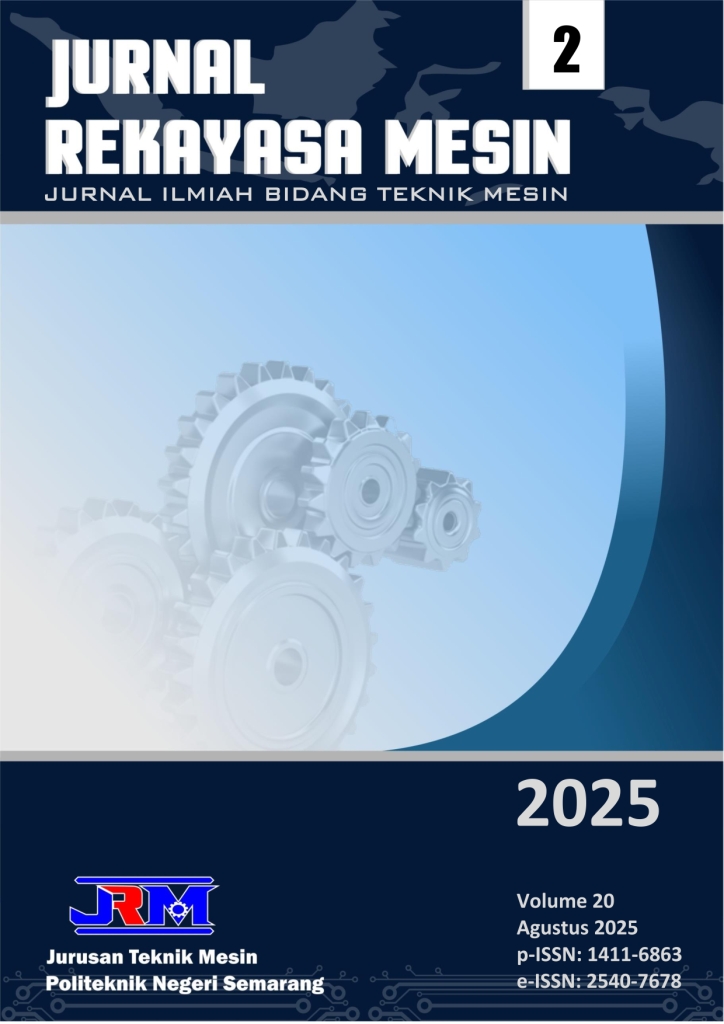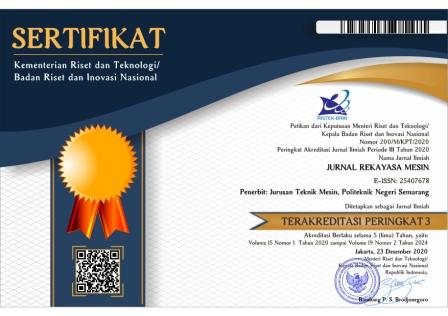Analysis of the Impact Toughness of Boehmeria Nivea Fiber-Reinforced Composites with UHMWPE Matrix as Potential Biomaterials
DOI:
https://doi.org/10.32497/jrm.v20i2.6109Keywords:
bone implant plate, composite, Scanning Elektron Microscope, impact test.Abstract
Bone implants are generally made of metal materials that have the strength and toughness to fuse broken or fractured bones, but they have the disadvantage of causing pain due to the metal's ability to absorb ambient temperatures and the relatively high cost of implant materials. Therefore, Ultra High Molecular Weight Polyethylene (UHMWPE) reinforced with hemp fiber is needed. This study aims to analyze impact toughness and observations on fracture cross-sections. This study uses a composite of hemp fiber (SR) with a UHMWPE (UP) matrix, which will be made using the hot press method. The research method used is an experimental method to determine the effect of adding material mixtures by varying the volume fraction of the composite fiber. The volume fraction variations used included 3% SR: 97% UP, 5% SR: 95% UP, and 7% SR: 93% UP. The test specimens referred to the ASTM D5942 standard for impact testing. The impact test results showed that the highest impact toughness value was 0.0514 J/mm2 in the 3%SR : 97%UP variation and the lowest impact toughness value was 0.0478 J/mm2 in the 7%SR : 93%UP variation. SEM observations of the fracture cross-section revealed failures caused by fiber pull-out, debonding, and matrix cracking.
References
D. Chandramohan, J. Bharanichandar, P. Karthikeyan, R. Vijayan, and B. Murali, “Progress of biomaterials in the field of orthopaedics,” Am. J. Appl. Sci., vol. 11, no. 4, pp. 623”“630, 2014, doi: 10.3844/ajassp.2014.623.630.
N. Hassanein, H. Bougherara, and A. Amleh, “In- vitro evaluation of the bioactivity and the biocompatibility of a novel coated UHMWPE biomaterial for biomedical applications,” J. Mech. Behav. Biomed. Mater., vol. 101, no. April 2019, p. 103409, 2020, doi: 10.1016/j.jmbbm.2019.103409.
O. Faruk et al., “A Comprehensive Review of Ultrahigh Molecular Weight Polyethylene Fibers for Applications Based on Their Different Preparation Techniques,” Adv. Polym. Technol., vol. 2023, 2023, doi: 10.1155/2023/6656692.
F. Di Puccio and L. Mattei, “Biotribology of artificial hip joints,” World J. Orthop., vol. 6, no. 1, pp. 77”“94, 2015, doi: 10.5312/wjo.v6.i1.77.
F. S. Senatov, A. N. Kopylov, N. Y. Anisimova, M. V. Kiselevsky, and A. V. Maksimkin, “UHMWPE-based nanocomposite as a material for damaged cartilage replacement,” Mater. Sci. Eng. C, vol. 48, pp. 566”“571, 2015, doi: 10.1016/j.msec.2014.12.050.
J. Li et al., “Synthetic skull bone defects for automatic patient-specific craniofacial implant design,” Sci. Data, vol. 8, no. 1, pp. 1”“8, 2021, doi: 10.1038/s41597-021-00806-0.
P. H. P. M. da Silveira et al., “Characterization of Thermo-Mechanical and Chemical Properties of Polypropylene/Hemp Fiber Biocomposites: Impact of Maleic Anhydride Compatibilizer and Fiber Content,” Polymers (Basel)., vol. 15, no. 15, pp. 1”“23, 2023, doi: 10.3390/polym15153271.
A. Salem and A. Bala, “Characterization and Processing of Composite Pp/Uhmwpe Filament for Fused Deposition Modelling Application,” no. September, 2017.
R. Mayerni, “Potensi pengembangan rami (Boehmeria Nivea (L.) Gaud) Sebagai Tanaman Serat Alternatif Di Sumatera Barat,” 2019.
J. K. Hirwani and S. K. Sinha, “Bio-tribological studies of Structalit/UHMWPE composites as an alternative to UHMWPE for hip joint application,” Wear, vol. 518”“519, no. January, p. 204630, 2023, doi: 10.1016/j.wear.2023.204630.
M. Hussain et al., “Ultra-high-molecular-weight-polyethylene (UHMWPE) as a promising polymer material for biomedical applications: A concise review,” Polymers (Basel)., vol. 12, no. 2, pp. 1”“28, 2020, doi: 10.3390/polym12020323.
A. Purboputro, Pramuko Ilmu; Hariyanto, “Analisis sifat tarik dan impak komposit serat rami dengan perlakuan alkali dalam waktu 2,4,6, dan 8 jam bermatriks poliester,” Journals.Ums, vol. 18, no. 2, pp. 64”“75, 2017, [Online]. Available: https://journals.ums.ac.id/index.php/mesin/article/view/5238/3476
N. C. Parasnis and K. Ramani, “Analysis of the effect of pressure on compression moulding of UHMWPE,” J. Mater. Sci. Mater. Med., vol. 9, no. 3, pp. 165”“172, 1998, doi: 10.1023/A:1008871720389.
A. Nurhidayat and Wijoyo, “Pengaruh Fraksi Volume Serat Cantula Terhadap Ketangguhan Impak Komposit Cantula-Hdpe Daur Ulang Sebagai Bahan Core Lantai Ramah Lingkungan,” Pros. SNATIF Ke 1. Fak. Tek. Mesin-Universitas Muria Kudus, no. 1, pp. 145”“152, 2014.
B. T. Mulyo and H. Yudiono, “Analisis Kekuatan Impak Pada Komposit Serat Daun Nanas Untuk Bahan Dasar Pembuatan Helm SNI,” J. Kompetensi Tek., vol. 10, no. 2, pp. 1”“8, 2018.
Downloads
Published
How to Cite
Issue
Section
License
Copyright (c) 2025 Swastika Pascal Rafsanjanu, Sri Hastuti, Fuad Hilmy, Eko Saputra, Wahyu Isti Nugroho, Farika Tono Putri, and Ragil Tri Indrawati

This work is licensed under a Creative Commons Attribution-NonCommercial-ShareAlike 4.0 International License.
Copyright of articles that appear in Jurnal Rekayasa Mesin belongs exclusively to Penerbit Jurusan Teknik Mesin Politeknik Negeri Semarang. This copyright covers the rights to reproduce the article, including reprints, electronic reproductions, or any other reproductions of similar nature.







